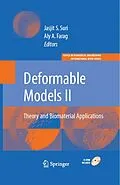Deformable Models: Theory and Biomaterial Applications is the second installation in the two-volume set Deformable Models which provides a wide cross-section of the methods and algorithms of variational and PDE methods in biomedical image analysis. The chapters are written by well-known researchers in this field, and the presentation style goes beyond an intricate abstraction of the theory into real application of the methods and description of the algorithms that were implemented. As such these chapters will serve the main goal of the editors of the volumes in bringing down to earth the latest in variational and PDE methods in modeling of soft tissues, covering the theory, algorithms, and applications of level sets and deformable models in medical image analysis.
Overall, the chapters of this volume provide an elegant cross-section of the theory and application of variational and PDE approaches in medical image analysis. Graduate students and researchers at various levels of familiarity with these techniques will find the volume very useful for understanding the theory and algorithmic implementations. In addition, the various case studies provided demonstrate the power of these techniques in clinical applications.
Researchers at various levels will find these chapters useful to understand the theory, algorithms, and implementation of many of these approaches.
Autorentext
Aly A. Farag received the bachelor degree from Cairo University, Egypt and the PhD degree from Purdue University in Electrical Engineering. He also holds master degrees in bioengineering from the Ohio State and the University of Michigan. He is a University Scholar and Professor of Electrical & Computer Engineering at the University of Louisville. Dr. Farag is the founder and director of the Computer Vision and Image Processing Laboratory (CVIP Lab) which focuses on imaging science, computer vision and biomedical imaging. Dr. Farag main research focus is 3D object reconstruction from multimodality imaging, and applications of statistical and variational methods for object segmentation and registration. He has authored over 250 technical papers in the field of image understanding and holds a number patents. He is regular reviewer to a number of professional organizations in the United States and abroad, and a member of the editorial boards of a number journals and international meetings.
Jasjit S. Suri, PhD is an innovator, scientist, a visionary, and industrialist and an internationally known world leader in Biomedical Engineering and Biological Sciences. Dr. Suri has spent over 20 years in the field of biomedical engineering, devices and its management. He received his Doctorate from the University of Washinton, Seattle and Master's in Executive Business Management from Weatherhead, Case Western Reserve University, Cleveland, Ohio. Dr. Suri was crowned with the President's Gold Medal in 1980 and elected as a Fellow of the American Institute for Medical and Biological Engineering.
Zusammenfassung
In the biomedical field, biomedical imagery has come to be a discipline of its own, given the nature of its applications in the understanding of the human body and medical diagnostics. The understanding of Deformable Models are the significant utility on biomedical imagery primarily because of its ability to perform efficient topology preservation and fast shape recovery. This has dominated the binary, grayscale and color imaging frameworks, which the eye can perceive. It has not only the ability to find boundaries and surfaces that are deep-seated in 2-D and 3-D volumes respectively, but also provide satisfactory solutions for the completion of cognitive objects with missing boundaries.
Deformable Models: Theory and Biomaterial Applications focuses on the core image processing techniques: theory and biomaterials useful to research and industry.
Inhalt
T-Surfaces Framework For Offset Generation And Semiautomatic 3d Segmentation.- Parametric Contour Model In Medical Image Segmentation.- Deformable Models And Their Application In Segmentation Of Imaged Pathology Specimens.- Image Segmentation Using The Level Set Method.- Parallel Co-Volume Subjective Surface Method For 3d Medical Image Segmentation.- Volumetric Segmentation Using Shape Models In The Level Set Framework.- Medical Image Segmentation Based On Deformable Models And Its Applications.- Breast Strain Imaging: A Cad Framework.- Alternate Spaces For Model Deformation: Application Of Stop And Go Active Models To Medical Images.- Deformable Model-Based Segmentation Of The Prostate From Ultrasound Images.- Segmentation Of Brain Mr Images Using J-Divergence Based Active Contour Models.- Morphometric Analysis Of Normal And Pathologic Brain Structure Via High-Dimensional Shape Transformations.- Efficient Kernel Density Estimation Of Shape And Intensity Priors For Level Set Segmentation.- Volumetric Mri Analysis Of Dyslexic Subjects Using A Level Set Framework.- Analysis Of 4-D Cardiac Mr Data With Nurbs Deformable Models: Temporal Fitting Strategy And Nonrigid Registration.- Robust Neuroimaging-Based Classification Techniques Of Autistic Vs. Typically Developing Brain.
